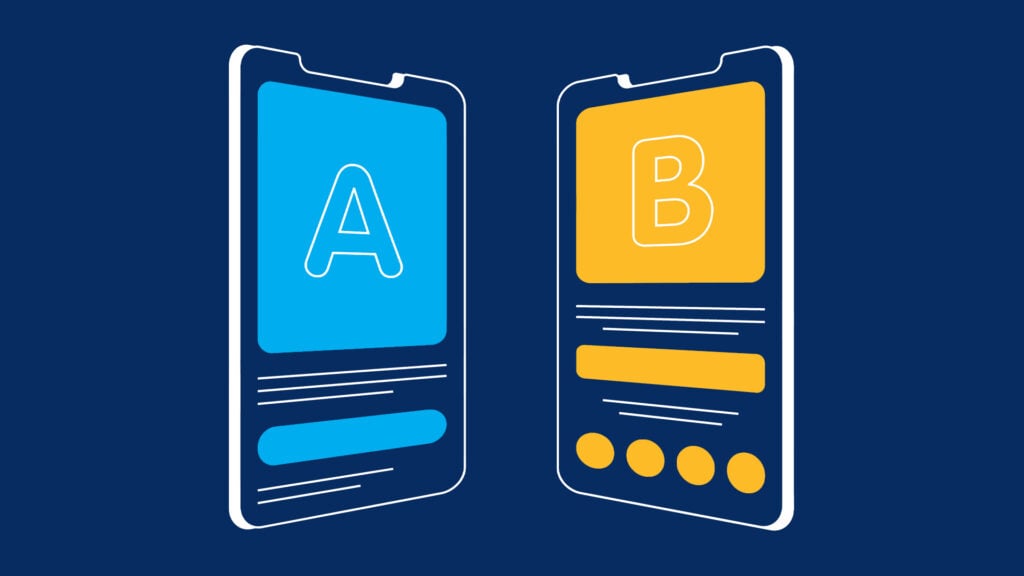Make the most out of your A/B testing strategy
In paid media, A/B testing is considered a cornerstone method. Yet it’s often misunderstood and misapplied, and not always worth your time and budget. This guide cuts through the hype to help you make smarter decisions about when to test, how to do it right and what those results mean in the real world.
The truth about A/B testing in paid media
Behind every great marketing decision is data, not guesswork. A/B testing—when approached strategically—transforms vague hunches into concrete insights on everything from creative elements to technical campaign parameters. From images and copy to bid strategies and audience targeting, proper testing illuminates the path to optimization.
What A/B testing actually means (and how it’s changed)
Over the past 10-15 years, the true definition of paid media A/B testing has become somewhat murky. Traditional A/B testing compares your original control design (A) to a separate variant (B), changing just one variable, like a headline, image or campaign objective. It requires segmenting your audience into two groups: one seeing only the control, the other seeing only the variant.

But here’s the reality check: many marketers have broadened the application of A/B testing to now include informally deploying both versions to the same audience simultaneously and letting the algorithm of the paid media platform optimize toward the best performer. Both approaches have their place depending on your duration, budget and audience size.
When A/B testing makes sense
Not every campaign needs a test. Consider these factors before diving in:
- Make it a lab experiment: You need statistical significance, which means a sufficiently large audience. If your audience is too small, your results might be as reliable as a weather forecast two weeks out. Use a sample size calculator to determine if you have enough audience to make testing worthwhile.
- One variable at a time, please: Testing multiple variables simultaneously is like trying to figure out which ingredient ruined your recipe when you changed five things at once. Keep it simple with one change: a headline, bid strategy or audience type. Anything more becomes multivariate testing, requiring more rigorous analysis.
- Know what victory looks like: Set a clear hypothesis upfront like “I hypothesize the variant will yield a lower cost-per-conversion than the control.” Define success before you start so you don’t move the goalposts later.
- Patience is a virtue: Good tests need time to collect meaningful data. For higher volume paid search campaigns, Brad Geddes of Search Engine Land recommends at least 1,000+ impressions, 1,000+ clicks, and 20+ conversions. Lower-volume campaigns still need 350+ impressions, 300+ clicks, and 7+ conversions minimum. Resist the temptation to tweak midway through or you’ll contaminate your results!
The invisible forces working against your test
Even the most carefully designed test can be skewed by real-world variables like:
- Seasonal trends
- Competitors launching new campaigns
- Economic factors shifting consumer behavior
Keep these external factors in mind when analyzing your outcomes.
Making sense of your results (even when they’re underwhelming)
The fantasy: Every test reveals a clear winner that boosts your campaign performance.
The reality: You’ll often see marginal differences that leave you wondering if it was worth the effort. Here’s how to find value anyway:
- Small wins add up: Even minor improvements compound over time. Embrace those single-digit percentage gains and use them to make incremental improvements.
- Test throughout the year: What works in summer might flop in winter. A/B testing on a quarterly basis minimizes platform learning phases and accounts for seasonal variations in audience behavior.
- Stay focused on your primary metric: Keep your eye on your main objective, like cost-per-conversion, during the test. Don’t get distracted by secondary metrics like cost-per-mille, click-through rate or cost-per-click. Instead, leverage secondary metrics to make other improvements to scale performance, like lowering a cost-per-mille to help maximize results through your primary conversion rate.
The bottom line
A/B testing remains a powerful tool—but never a law—marketers can use at their disposal. Use it strategically when conditions are right and interpret results with context. Continuous testing prevents anomalies with the data and provides clear-cut trends that align with your audience year-round.
The next time you consider an A/B testing strategy, you’ll know exactly when to dive in and when to save your resources for battles worth fighting. By embracing A/B testing as a strategic tool rather than a mandatory practice, you can make smarter, data-driven decisions that drive meaningful results in your paid media campaigns.





